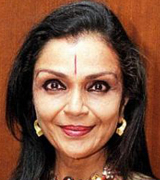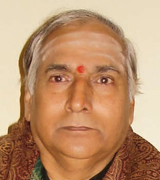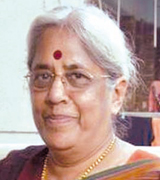COVER STORY
ANITA RATNAM - Classical roots, contemporary expressions
SUSHILA RAVINDRANATH

Anita Ratnam, a recipient of the Sangeet Natak Akademi Puraskar for Contemporary Dance for 2016, started out as a classical dancer when she made her stage debut at age nine. She decided to stop giving performances when she was approaching twenty. After that, she did not dance for more than ten years. When she returned, she ended up creating a new idiom of dance and winning awards on the way.
Anita Ratnam belongs to the TVS family, a major business group from Chennai, a pioneer in many ways. The family was steeped in tradition when Anita was growing up. Her mother Leela Ratnam, who would have loved to learn to dance but could not because good girls didn’t those days, made sure her daughter did. Anita had her early training under Rajee Narayan who taught her Bharatanatyam, items in Kathak and Manipuri and the plate dance. Her grandfather T.S. Rajam (her father’s father) did not approve of her dancing in public. The patriarch was seriously annoyed. However her mother and guru supported her and she did not stop dancing. After her arangetram in June 1964, Anita’s guru moved to Mumbai. Her mother sent her to train under Adyar Lakshman. She was twelve then.
PROFILE
S. Seshagiri Rao
S. SHASHIDHAR

`Veeneya Bedagidu Mysuru’ is one of the several epithets for Mysore. The erstwhile Mysore state has produced many illustrious stars in veena and a unique style known as the Mysore bani is in vogue even to this day. The region has produced great exponents in violin too. Sangita Kalanidhi T. Chowdiah, who introduced a seven-stringed violin in place of the conventional four-stringed one was the first violinist from Karnataka to reach the top echelons of Carnatic music. S. Seshagiri Rao has been the foremost among the following generations of excellent violinists in the state. He has been a reputed accompanist and soloist for more than six decades.
He was born in 1944 in a musical family in Bengaluru. Life was not a bed of roses for him as he lost his mother when he was just two years old. The responsibility of raising Seshagiri Rao and his elder brother Srinivasa Rao fell on the shoulders of his father H.S. Venkatasubba Rao, an accomplished violinist himself.
SPOTLIGHT
LAXMINARAYAN GARG - A life devoted to ‘Sangeet’
SAKUNTALA NARASIMHAN

Editing a 66-page monthly magazine devoted to music, without a break, for 62 years—without financial support or sponsorship of any kind, and without advertising revenue—must be a world record. In 2010 Sangeet, the magazine in Hindi, marked its 75th anniversary, while editor Dr. Laxminarayan Garg celebrated his own 75th birthday in 2007. The Garg family’s dedication to the propagation of music has put the small, obscure town of Hathras (near Aligarh, in U.P.) from where it is published, on the musical map of India through its regular coverage of not only classical Hindustani music but also folk music, film music and dance (all forms and traditions including Bharatanatyam, and obscure folk dance traditions of India on the verge of vanishing). One issue of 1963 was devoted entirely to Carnatic music (including descriptions of 1001 ragas, notation, talas, forms like chauka varnam, kritis, tillana and javalis, traditions of improvisation like alapana, kalpana swaram and niraval.) The twelve issues of 2016 had a south Indian (Tanjavur) veena on the cover—which is more than one can say of other magazines of the north devoted to music.
THEATRE
Reflections on the Indian stage
Mahesh Elkunchwar

Born in 1949, Kirti Jain, is an M.A. in English Literature from Delhi University and has a diploma in Theatre (specialisation in Direction) from the National School of Drama (NSD). She joined NSD in 1977 as Assistant Professor in Indian Theatre History and went on to head the institute as its Director for seven years (1988-1995). During her tenure she initiated the Theatre in Education Company at NSD, its Documentation and Publication Programme and a Regional Resource Centre in Bengaluru. She has directed several plays for NSD and others. Hayavadana (1982), Ashadh ka Ek Din (1980), Lahron ke Rajhans (1992), and Holi (1998), are some notable plays she directed. Her well known directorial work includes Tinka Tinka,Ek Ruka Hua Faisla,Aur Kitne Tukde about the Partition; Kaun Thagwa Nagaria Lootal Ho on globalisation; Sab Kuch Chakachak, a play for young people about displacement; Baghdad Burning, which evolved from a blog on the American invasion of Iraq; and Hamara Shahar Us Baras about the fallout of communal unrest. She has documented the performances and work processes of several Indian theatre directors, with a focus on women directors. She has published articles in theatre anthologies, and is associated with the publication of a Hindi theatre journal. Her most recent publication is an edited volume titled, Badal Sircar: Search for a Language of Theatre, released in November 2016. She is also a member of the editorial board of the theatre journal Studies in Theatre and Performance, published by Exeter University. Additionally, Kirti Jain has contributed essays for the Companion to the Indian Theatre and Oxford Encyclopaedia of Theatre and Performance. She participates in conferences, conducts workshops and gives lectures on theatre, both at the national and international level. She is a founder member of the Board of Trustees of Natarang Pratishthan—a theatre archives and documentation centre. In this capacity she has curated several international conferences and festivals including Poorva—a festival and conference of Asian Women Theatre Directors.
Apart from her contributions to theatre, Kirti Jain also had a short stint in television as a producer. She is engaged in evolving a methodology of drama to be introduced in the school curriculum. A recipient of several awards and felicitations, Kirti Jain was honoured with the B.V. Karanth Smriti Puraskar for her contribution to theatre (2010) and the Central Sangeet Natak Akademi award for theatre direction (2011).


